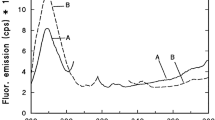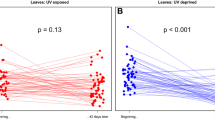Abstract
Grapevine plants (Vitis vinifera L. cv. Silvaner) were cultivated under shaded conditions in the absence of UV radiation in a greenhouse, and subsequently placed outdoors under filters transmitting natural radiation, or screening out the UV-B (280 to 315 nm), or screening out the UV-A (315 to 400 nm) and the UV-B spectral range. All conditions decreased maximum chlorophyll fluorescence (FM) and increased minimum chlorophyll fluorescence (F0) from dark-adapted leaves; however, with increasing UV, FM quenching was stimulated but increases in F0 were reduced. The FV/FM ratio (where FV=FM-F0) was clearly reduced by visible radiation (VIS): UV-B caused a moderate extra-reduction in FV/FM. Exposure of leaves (V. vinifera L. cv. Bacchus) to UV or VIS lamps quenched the FM to similar extents; further, UV-B doses comparable to the field, quenched F0. A model was developed to describe how natural radiation intensities affect PS II and thereby change leaf fluorescence. Fitting theory to experiment was successful when the same FM yield for UV- and VIS-inactivated PS II was assumed, and for lower F0 yields of UV- than for VIS-inactivated PS II. It is deduced, that natural UV can produce inactivated PS II exhibiting relatively high FV/FM. The presence of UV-inactivated PS II is difficult to detect by measuring FV/FM in leaves. Hence, relative concentrations of intact PS II during outdoor exposure were derived from FM. These concentrations, but not FV/FM, correlated reasonably well with CO2 gas exchange measurements. Consequently, PS II inhibition by natural UV could be a main factor for UV inhibition of photosynthesis.
Similar content being viewed by others
References
Agati G, Cerovic ZG and Moya I (2000) The effect of decreasing temperature up to chilling values on the in vivo F685/F735 chlorophyll fluorescence ratio in Phaseolus vulgaris and Pisum sativum: the role of the Photosystem I contribution to the 735 nm fluorescence band. Photochem Photobiol 72: 75–84
Allen DJ, Nogués S and Baker NR (1998) Ozone depletion and increased UV-B radiation: is there a real threat to photosynthesis? J Exp Bot 49: 1775–1788
Allen JF (1992) Protein phosphorylation in regulation of photosynthesis. Biochim Biophys Acta 1098: 275–335
Andersson B (1992) Thylakoid membrane dynamics in relation to light stress and photoinhibition. In: Barber B, Guerrero MG and Medrano H (eds) Trends in Photosynthesis Research, pp 71–86. Intercept, Andover, UK
Barber J, Malkin S and Telfer A (1989) The origin of chlorophyll fluorescence in vivo and its quenching by the Photosystem II reaction centre. Phil Trans R Soc London Ser B: 323: 227–239
Barth C, Krause GH and Winter K (2001) Responses of Photosystem I compared with Photosystem II to highlight stress in tropical shade and sun leaves. Plant Cell Environ 24: 163–176
Bilger W, Veit M, Schreiber L and Schreiber U (1997) Measurement of leaf epidermal transmittance of UV radiation by chlorophyll fluorescence. Physiol Plant 101: 754–763
Briantais J-M, Vernotte C, Krause GH and Weis E (1986) Chlorophyll a fluorescence of higher plants: chloroplasts and leaves. In: Govindjee, Amesz J and Fork DJ (eds) Light Emission by Plants and Bacteria, pp 539–583. Academic Press, New York
Butler WL (1978) Energy distribution in the photochemical apparatus of photosynthesis. Ann Rev Plant Physiol 29: 345–378
Demmig B and Björkman O (1987) Comparison of the effect of excessive light on chlorophyll fluorescence (77 K) and photon yield of O2 evolution in leaves of higher plants. Planta 171: 171– 184
Demmig-Adams B, Gilmore AM and Adams III WW(1996) In vivo functions of carotenoids in higher plants. FASEB J 10: 403–412
Genty B, Wonders J and Baker NR (1990) Non-photochemical quenching of F0 in leaves is emission wavelength dependent: consequences for quenching analysis and its interpretation. Photosynth Res 26: 133–139
Greenberg BM, Gaba V, Canaani O, Malkin S, Mattoo AK and Edelmann M (1989) Separate photosensitizers mediate degradation of the 32-kDa Photosystem II reaction center protein in the visible and UV spectral regions. Proc Natl Acad Sci USA 86: 6617–6620
Greer DH, Laing WA and Kipnis T (1988) Photoinhibition of photosynthesis in intact kiwifruit (Actinidia deliciosa) leaves: effect of temperature. Planta 174: 152–158
Ihle C (1977) Degradation and release from the thylakoid membrane of Photosystem II subunits after UV-B irradation of the liverwort Conocephalum conicum. Photosynth Res 54: 73–78
Iwanzik W, Tevini M, Dohnt G, Voss M, Weiss W, Gräber P and Renger G (1983) Action of UV-B radiation on photosynthetic primary reactions in spinach chloroplasts. Physiol Plant 58: 401– 407
Jordan BR (1996) The effects of ultraviolet-B radiation on plants: a molecular perspective. Adv Bot Res 22: 97–162
Kok B (1956) On the inhibition of photosynthesis by intense light. Biochim Biophys Acta 21: 234–244
Kolb C, Käser M, Kopeck+ J, Zotz G, Riederer M and Pfündel E (2001) Effects of natural intensities of visible and UV radiation on epidermal UV-screening and photosynthesis in grape leaves (Vitis vinifera cv. Silvaner). Plant Physiol 127: 863–875
Krause GH (1994) Photoinhibition induced by low temperatures. In: Baker NR and Bowyer JR (eds) Photoinhibition of Photosynthesis, from Molecular Mechanisms to the Field, pp 331–348. BIOS Scientific Publishers, Oxford, UK
Krause GH and Weis E (1991) Chlorophyll fluorescence and photosynthesis: the basics. Annu Rev Plant Physiol Plant Mol Biol 42: 313–349
Krause GH, Schmude C, Garden H, Koroleva OY and Winter K (1999) Effects of solar ultraviolet radiation on the potential efficiency of Photosystem II in leaves of tropical plants. Plant Physiol 121: 1349–1358
Lee H-Y, Hong Y-N and Chow WS (2001) Photoinactivation of Photosystem II complexes and photoprotection by non-functional neighbours in Capsicum annuum L. leaves. Planta 212: 332–342
Marangoni R, Gioffré D, Colombetti G, Lebert M and Häder DP (2000) ELDONET – European Light Dosimeter Network. J Photochem Photobiol B Biol 58: 178–184
Melis A (1991) Dynamics of photosynthetic membrane composition and function. Biochim Biophys Acta 1058: 87–106
Noorudeen AM and Kulandaivelu G (1982) On the possible site of inhibition of photosynthetic electron transport by ultraviolet-B (UV-B) radiation. Physiol Plant 55: 161–166
Ögren E and Öquist G (1984) Photoinhibition of photosynthesis in Lemna gibba as induced by the interaction between light and temperature. II. Photosynthetic electron transport. Physiol Plant 62: 187–192
Öquist G, Chow WS and Anderson JM (1992) Photoinhibition of photosynthesis represents a mechanism for the long-term regulation of Photosystem II. Planta 186: 450–460
Pfündel EE (1998) Estimating the contribution of Photosystem I to total leaf chlorophyll fluorescence Photosynth Res 56: 185–195
Pfündel EE and Bilger W (1994) Regulation and possible function of the violaxanthin cycle. Photosynth Res 42: 89–109
Pfündel EE, Pan R-S and Dilley RA (1992) Inhibition of violaxanthin deepoxidation by ultraviolet-B radiation in isolated chloroplasts and intact leaves. Plant Physiol 98: 1372–1380
Santabarbara S, Neverov KV, Garlaschi FM, Zucchelli G and Jennings RC (2001) Involvement of uncoupled antenna chlorophylls in photoinhibition in thylakoids. FEBS Lett 491: 109–113
Sass L, Spetea C, Máté Z, Nagy T and Vass I (1997) Repair of UVB induced damage of Photosystem II via de novo synthesis of the D1 and D2 reaction centre subunits in Synechocystis sp. PCC 6803. Photosynth Res 54: 55–62
Schreiber U, Schliwa U and Bilger W (1986) Continuous recording of photochemical and non-photochemical chlorophyll fluorescence quenching with a new type of modulation fluorometer. Photosynth Res 10: 51–62
Searles PS, Flint SD and Caldwell MM (2001) A meta-analysis of plant field studies simulating stratospheric ozone depletion. Oecologia 127: 1–10
Somersalo S and Krause GH (1988) Changes in chlorophyll fluoresence related to photoinhibition of photosynthesis and cold acclimation of green plants. In: Lichtenthaler HK (ed) Applications of Chlorophyll Fluorescence, pp 157–164. Kluwer Academic Publishers, Dordrecht, The Netherlands
Tevini M and Iwanzik W (1983) Inhibition of photosynthetic activity by UV-B radiation in radish seedlings. Physiol Plant 58: 395–400
Tevini M and Pfister K (1985) Inhibition of Photosystem II by UVB-radiation. Z Naturforsch 40c: 129–133
Turcsányi E and Vass I (2000) Inhibition of photosynthetic electron transport by UV-A radiation targets the Photosystem II complex. Photochem Photobiol 72: 513–520
Tyystjärvi E and Aro E-M (1996) The rate constant of photoinhibition, measured in lincomycin-treated leaves, is directly proportional to light intensity. Proc Natl Acad Sci USA 93: 2213–2218
van Hasselt PR, Chow WS and Anderson JM (1996) Short-term treatment of pea leaves with supplementary UV-B at different oxygen concentrations: impacts on chloroplast and plasma membrane bound processes. Plant Sci 120: 1–9
Vass I (1997) Adverse effects of UV-B light on the structure and function of the photosynthetic apparatus. In: Pessarakli M (ed) Handbook of Photosynthesis, pp 931–949. Marcel Dekker, New York
Xiong FS and Day TA (2001) Effect of solar ultraviolet-B radiation during springtime ozone depletion on photosynthesis and biomass production of Antarctic vascular plants. Plant Physiol 125: 738–751
Author information
Authors and Affiliations
Rights and permissions
About this article
Cite this article
Pfündel, E.E. Action of UV and visible radiation on chlorophyll fluorescence from dark-adapted grape leaves (Vitis vinifera L.). Photosynthesis Research 75, 29–39 (2003). https://doi.org/10.1023/A:1022486925516
Issue Date:
DOI: https://doi.org/10.1023/A:1022486925516




